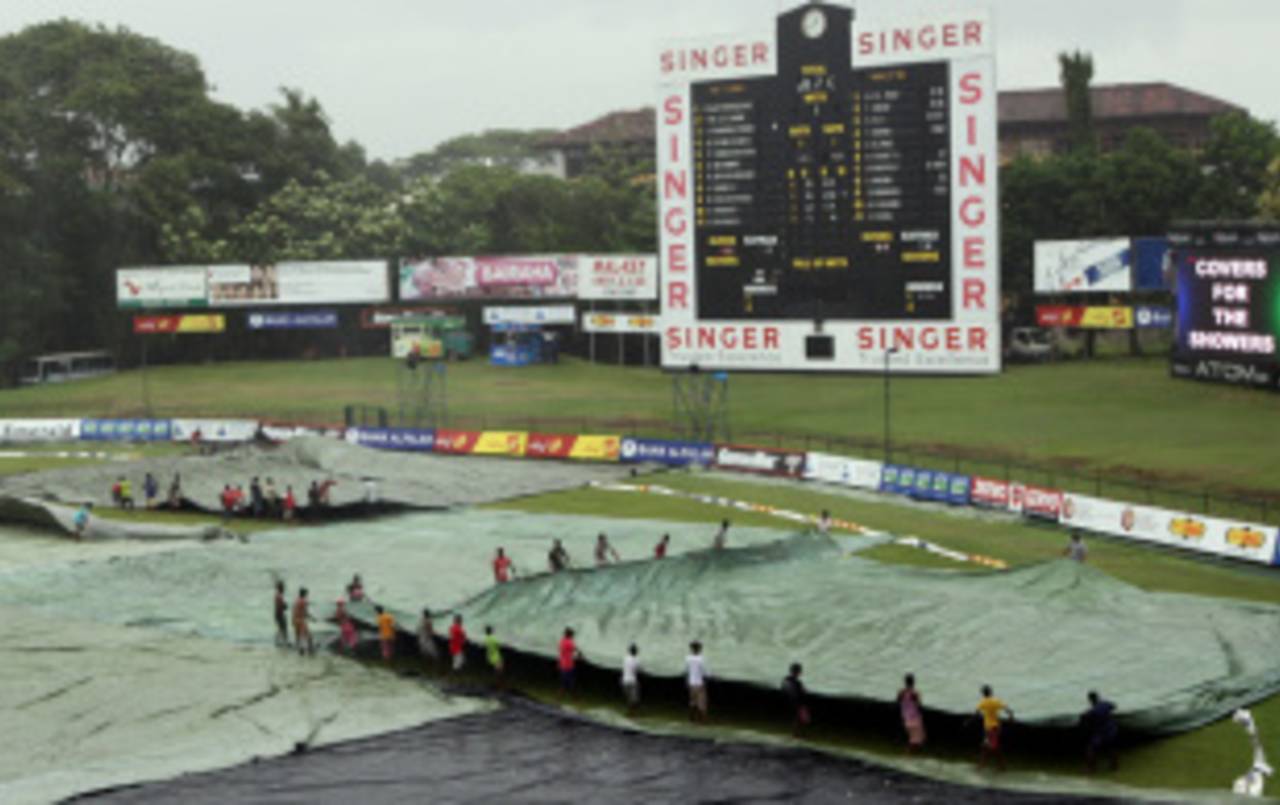DRS drama, and Sri Lanka move on from Murali
Five key factors and observations from the Test series between Sri Lanka and Pakistan

Rain was an irritant for a considerable part of the tour • Getty Images
Pakistan's coach Dav Whatmore demanded to know why it wasn't available. Mohammad Hafeez was more moderate but shared his coach's views. During the first Test in Galle, both of them said the inconsistent implementation of the DRS was affecting the game. The system was available, without Hot Spot, in Sri Lanka's previous home series, against England. When Pakistan arrived, three months later, Sri Lanka Cricket couldn't provide it because of the costs involved. Pakistan had reason to feel aggrieved. They had seven decisions going against them in the first three days of the Galle Test, with several inside edges on to pad going undetected and doubts over the trajectory of the ball during lbw decisions.
The groundstaff was kept busy right through the tour. Rain washed out the third one-day international in Colombo, and the clouds were unwelcome visitors in two of the three Tests. The weather didn't effect the Galle Test, but in spoiled the contests in Colombo and Pallekele. It ruined several hours of play on the second, third and fourth days at the SSC, making a draw inevitable. The flat pitch raised doubts about the likelihood of a result, but with Pakistan taking a 160-run lead, they could have tried to force a result if it wasn't for the stoppage time. In Pallekele, rain wiped out the entire second day, which meant both teams were short of time to push for a result.
Though Pakistan lost the ODIs and Tests, the Test series defeat wasn't as demoralising because of the performances of their younger players. Asad Shafiq and Azhar Ali have been on the national circuit for the last two years, and their performances made up for the patchy form of Misbah and Younis Khan. Azhar impressed with his temperament and patience needed to play long innings; Shafiq displayed similar qualities and tightened his technique. Their innings in the final Test gave Pakistan the belief that they could save the game. Junaid Khan was a revelation with his pace, swing and aggression. Inspired by Wasim Akram, he got the ball to reverse from the round the wicket to the right-handers. He overshadowed Saeed Ajmal with his top-order strikes but lacked support. Junaid had to shoulder a lot of the burden because Aizaz Cheema, Umar Gul and Mohammad Sami turned in underwhelming performances.
When Mahela Jayawardene took over the leadership after the tour of South Africa early this year, he was Sri Lanka's third captain in the last 12 months. His task of restoring the team's competitiveness was made tougher by the payment crisis. SLC was having financial problems and its national players were the biggest victims. The results, however, began to improve - Sri Lanka made the finals of the CB Series and won a Test against England. Jayawardene wanted a series win, which had eluded them for nearly three years. His aggressive and innovative fields showed that he was trying to create opportunities. His decision to call off Sri Lanka's chase of 271 in Pallekele had puzzled many, including Misbah, but having secured a 1-0 lead, Jayawardene didn't want to wreck several months of hard work for the sake of adventure.
Muttiah Muralitharan can relax now. Sri Lanka had found it hard to cope with his retirement two years ago. Ajantha Mendis' form was erratic and his fitness poor, leaving Rangana Herath with most of the responsibility. Herath has done well to come out of Murali's shadow and lead the spin attack. His challenge will be to create a threat on pitches that may not be as spin-friendly anymore. With Murali's departure, the emphasis has started to shift from spin to pace, and Sri Lanka will need more support from their seamers going forward. Bringing in the allrounder Thisara Perera for the third Test was an inspired move. His 4 for 63 and attacking 75 were good for his transition to the Test squad as a lower-order hitter and opening bowler. Nuwan Kulasekara was incisive in Galle, challenged at the SSC, but he is only building his experience at Test level. When Chanaka Welegedera and Suranga Lakmal return from injury, the competition for places will increase.
Kanishkaa Balachandran is a senior sub-editor at ESPNcricinfo